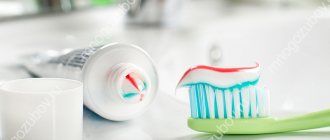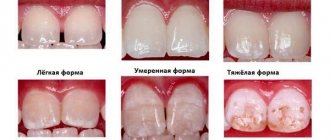- What are the benefits of fluoride?
- Why is fluoride deficiency dangerous?
- If there is too much fluoride in the body
- Fluoride products for teeth
- Water fluoridation
- Fluoride in toothpastes
- Can children have toothpaste with fluoride?
- Is there an alternative?
Most dental and oral care products contain fluoride. This is an important substance that helps strengthen enamel and prevents the spread of pathogenic microflora.
In the body, fluoride is contained in tooth enamel and bones in an amount of about 2.5–3 g. Our daily need for it is 1.5–5 mg. With a lack of this element, caries forms on the teeth. Therefore, in the USA and some European countries, fluoride is recommended for addition to drinking water and toothpastes.
Recently, articles have increasingly appeared that fluoride in toothpaste is harmful. Is it true? Let's try to figure it out.
What are the benefits of fluoride?
Fluoride performs important tasks in the body.
- Together with phosphorus and calcium, it participates in the formation and strengthening of bone tissue and tooth enamel
. - Promotes healthy nail and hair
. - Stimulates hematopoietic
: formation, development and maturation of red blood cells, platelets and leukocytes. - Strengthens the immune system
and maintains it at an appropriate level. - Removes salts of radionuclides and heavy metals
.
When used in oral care products, fluoride helps prevent dental problems and solve existing ones.
- Prevent tooth decay
. Fluoride penetrates the enamel structure, prevents caries and treats it at the white spot stage. - Protect against demineralization
. The combination of fluorine with hydroxyapatite (the main element of tooth enamel) forms fluorohydroxyapatite, a substance that restores it. This is how enamel remineralization occurs. - Protect against lactic acid
. Fluoride prevents bacteria from producing lactic acid. This reduces the growth of pathogenic microflora and gives the enamel additional protection.
Research
If serious poisoning is suspected, the patient is hospitalized. The following blood tests are performed in the hospital:
· Blood sugar (hypoglycemia).
· Electrolyte balance is especially important to monitor.
· Hypocalcemia is usually the most serious and pathogenic variable.
· Hypomagnesemia and hyperkalemia are also observed in poisoning.
· Fluoride poisoning can cause liver and kidney damage. ALT and creatinine should be measured.
Other studies:
· ECG and cardiac monitoring in severe cases. There may be a widened QRS complex, arrhythmia, shock, and cardiac arrest.
If there is too much fluoride in the body
Fluoride is found not only in oral care products and tap water, but also in food.
The maximum permissible daily intake is 10 mg. Other causes of excess fluoride:
- chronic intoxication with fluoride compounds at work;
- improper regulation of fluoride metabolism in the body.
An excess of fluoride is more dangerous for the body than a deficiency, as it entails irreversible processes. First of all, teeth and bones are affected; metabolic disorders, deterioration of blood clotting, etc. may occur. In children, even before teething, endemic fluorosis develops - this is a chronic lesion of tooth enamel in the form of spots of various sizes, shapes and colors. After 10–20 years of excess fluoride in the body, bone fluorosis develops, which can develop into osteosclerosis, osteoporosis and osteosarcoma (malignant formation).
Etiology and pathogenesis
· Gastrointestinal genes are often dominant. These genes are caused by the formation of irritant/corrosive and systemic hydrogen fluoride in the acidic environment of the stomach, which in turn causes gastrointestinal irritation and erosion.
· Fluoride tablets contain the filler sorbitol, which causes nausea, vomiting and diarrhea without necessarily consuming toxic doses of fluoride.
· Once F is absorbed, it binds to calcium and causes hypocalcemia. It is this hypocalcemia that is the main cause of the symptoms and consequences of poisoning.
· Fluorine also acts directly cytotoxic, affecting various cellular enzyme systems.
Fluoride in toothpastes
The fluoride concentration in toothpaste is measured in ppm or percentage. The abbreviation ppm stands for parts per million and reflects the number of fluorine particles per million. If the tube states that the paste contains 900 ppm of fluoride, this means that 1 kg will contain 900 mg of this element.
The higher the fluoride concentration, the better the paste restores enamel. For prophylactic pastes it is 950–1150 ppm, for therapeutic pastes it is 1350–1500 ppm.
Fluorine in pastes can be found in various compounds: amino fluorides, sodium fluorides, sodium monofluorophosphates, tin fluoride.
| Component | Name on the tube | A comment |
| Sodium monofluorophosphate | Sodium monofluorophosphate | It is ineffective because due to the rate of decay it begins to act only after 3–4 minutes of cleaning. |
| Sodium fluoride | Sodium fluoride | Has a powerful antibacterial and restorative effect. The active substance reduces the ability of bacteria to convert sugar into acid, which destroys enamel. |
| Aminofluoride | Aminofluoride/Olaflur | Recognized as the most effective for caries prevention. Forms a protective film on the surface of the teeth, from which fluoride enters the enamel and strengthens it. |
| Tin fluoride | Stannous fluoride | It is proven effective, but has a side effect: it first lightens the restored areas of enamel, and then leads to their noticeable darkening. |
We recommend choosing pastes with sodium fluoride or amino fluoride.
Toothpastes with sodium fluoride
Toothpaste CURAPROX Enzycal 1450
miradent mirasensitive hap+ toothpaste for sensitive teeth
Blanx Advanced Whitening Toothpaste
Toothpastes with amino fluoride
Miradent Mirafluor C Toothpaste
Elgidium toothpaste Protection against caries
Toothpaste ROCS (ROCS) Teens The aroma of a sultry summer. Strawberries (from 8 to…
Fluorine and fluorides are not the same thing
Often, opponents of the use of fluorine confuse key concepts: fluorine is a reactive gas that is poisonous to the human body, and fluorides, its octane-based derivatives, are absolutely harmless. Only fluorides (such as sodium fluoride) are used to make toothpaste. Moreover, their concentration in a tube of paste is strictly regulated.
ATTENTION! According to regulations, the permissible concentration of fluoride in toothpaste ranges from 1350 to 1650 ppm. This indicator depends on whether the paste is therapeutic and prophylactic or is intended purely for the prevention of caries (1ppm = 0.0001%).
Can children have toothpaste with fluoride?
The European Academy of Pediatric Dentistry (EAPD) recommends fluoride pastes and gels for everyone - even children and pregnant women - to prevent early stages of tooth decay. Children can begin brushing their teeth with fluoride-containing toothpastes when their first tooth erupts.
Recommended fluoride content in toothpaste:
- up to 4 years
- 200 ppm; - from 4 to 8 years
- 500 ppm; - over 6 years old
and for adults - 1450 ppm.
This recommendation is suitable for anyone living in areas with moderate levels of fluoride in drinking water. Up-to-date information on the fluoride content of water in your region can be found on the website of your local water utility or in our table.
Benefits of fluoride for teeth
The positive impact of microelements on the condition of teeth is difficult to overestimate. This is why fluoride toothpaste is widely advertised and recommended by dentists. The benefits of microelements for dental health are as follows:
- Fluorides improve metabolism.
- Fluoride stimulates the production of the salivary gland and slows down the formation of tartar.
- Fluoride ions inhibit the activity of harmful microorganisms in the oral cavity and prevent their destructive effects on tooth enamel.
- The trace element promotes tissue remineralization, i.e. allows you to restore damaged areas of teeth.
- Fluorides provide caries prevention.
Is there an alternative?
With the right approach and judicious use, fluoride is an effective way to treat and prevent tooth sensitivity, caries and enamel demineralization. But, if you still have doubts, there is an alternative - pastes with synthetic hydroxyapatite.
This hydroxyapatite is completely identical to natural hydroxyapatite, the one that makes up tooth enamel. The substance is easily integrated into the crystal lattice of the enamel, strengthening it, reducing sensitivity and preventing the development of caries. The only drawback is that pastes with hydroxyapatite are more expensive than fluoride-containing ones.
OK! And how does this happen?
Let's remember our unclean hydroxylapatite. The purer the mineral, the more stable its crystal chain and the more difficult it is to destroy. And this is exactly what we want to prevent – the destruction of tooth enamel! Small ions that mix in a crystalline chain usually disrupt its structure. Exception: fluoride ions! The fluoride ion is very small; if it takes the place of a hydroxide in a crystalline chain, then the entire chain becomes significantly denser. In the presence of a small amount of fluoride ions, fluorapatite or hydroxyfluorapatite is formed, which is much more stable than hydroxylapatite!
Fluorapatite – remains strong in acid!
Hydroxyapatite is destroyed!
That is, while fluoride ions are in saliva or in dental plaque, they can penetrate the apatite structure and thereby slow down the destruction of enamel or completely prevent it = REMINERALIZATION! The tooth has the ability to recover.
Let's say this is true! But surely there is an alternative to fluorides???
Fluoride prophylaxis methods
There are two main methods of fluoride prophylaxis - systemic and local.
Systemic means taking fluoride orally. Fluoride can enter our body with fluoridated water, milk, salt and as part of special tablets. Ultimately, it exerts its preventive and therapeutic effects by being released into the oral cavity with saliva.
Local fluoride prophylaxis is the use of fluoride preparations externally, directly applying them to the teeth. The effectiveness of such drugs depends on several factors:
– on the chemical compound of fluorine, its properties and concentration;
– dosage form of the drug, frequency of its use;
– on the properties of the oral cavity (enamel, oral fluid, hygiene).
Reverse osmosis plants for purifying fluoride from water
Reverse osmosis plants differ from other types of water treatment equipment in their high productivity and the deepest degree of water purification from fluorine, heavy metal salts, and organic impurities. They are capable of working around the clock, continuously purifying intense water flows in large volumes.
It is beneficial to use the reverse osmosis method to purify water from fluoride. It retains F(-) ions and other impurities, allowing only water molecules to pass through the pores. This ensures output purity of up to 98%. You can set several degrees of purification and separate water flows: for drinking, for household needs.
Osmosis for all industries
To purify large volumes of water, we will assemble a powerful industrial reverse osmosis installation with a line of membrane filters to remove fluoride from water, which operate effectively when the fluoride concentration is exceeded. We will place the necessary elements on a stainless steel frame. We will install shut-off and control equipment, local water supply systems.
We can offer companies equipment of various capacities:
- up to 250 l/hour - for small production,
- up to 500 l/hour - for medium-sized enterprises,
- up to 2000 l/hour - for water supply of especially large industries.
Industrial reverse osmosis units are suitable for any production area that requires clean technical and process fluid. They will allow you to obtain high-quality purification (less than 1 µS/cm), which is very important for microelectronics, for obtaining clean water for laboratories or for preparing injection solutions.
Osmosis for home, for use in households
A membrane filter for water purification from fluoride based on reverse osmosis, installed in a compact household unit, will perfectly cope with everyday tasks. It will fit in a small corner under the sink and provide the whole house with clean water at once.
To reduce the cost of the kit, you can use different methods of purifying water from fluoride. To obtain drinking water, install osmosis with fluoride water filters in the kitchen, and use cartridges that provide less deep cleaning in the bathroom or shower. The external effects of fluorides are not as dangerous as their destructive effect on the body when ingested with drinking water.
Progress, complications and prognosis
Make sure fluoride medications are not available to young children.
Gradient
Typically, symptoms of fluoride poisoning occur in less than 1 hour. However, in some cases, symptoms do not appear until several hours after ingestion.
Complications
· The cause of death is usually circulatory or respiratory failure.
· Damage to the liver and kidneys occurs.
· Repeated and long-term abuse of fluoride can lead to dental or skeletal fluorosis.
Forecast
Most exposures resolve without any symptoms. Fluoride poisoning is common in young children, but the condition can be prevented by keeping tablets and the like out of the child's reach.
Ingestion of toothpaste containing F is also common in children. Poisoning is rarely life-threatening and usually does not cause complications.










